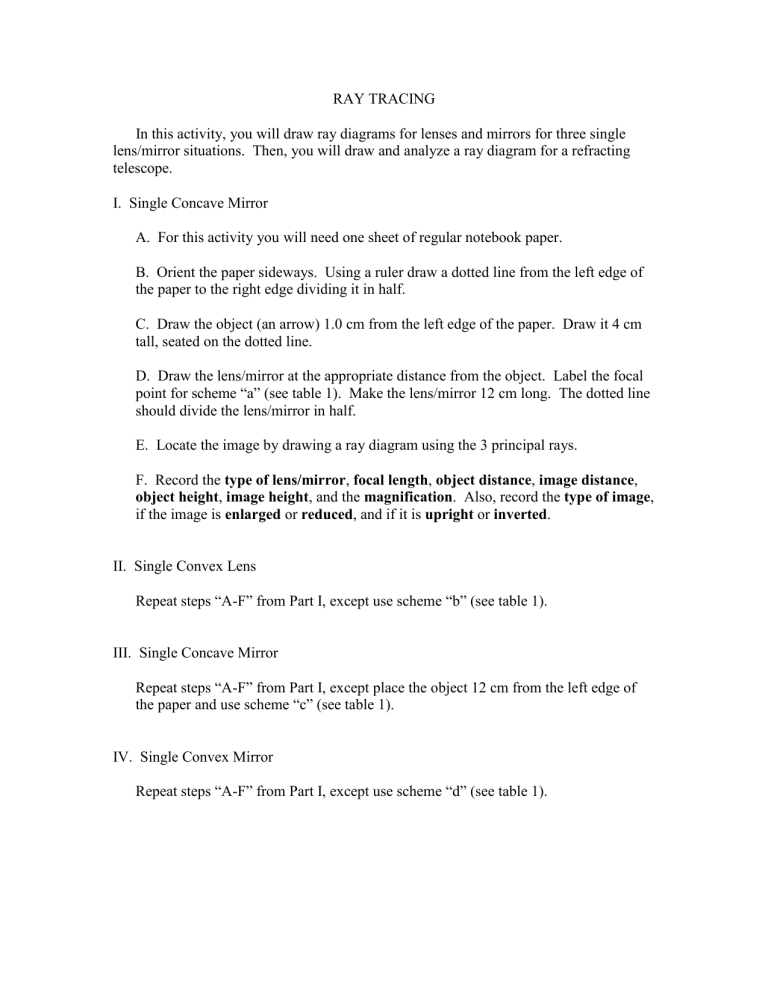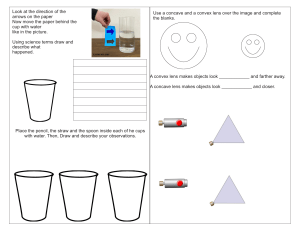
RAY TRACING In this activity, you will draw ray diagrams for lenses and mirrors for three single lens/mirror situations. Then, you will draw and analyze a ray diagram for a refracting telescope. I. Single Concave Mirror A. For this activity you will need one sheet of regular notebook paper. B. Orient the paper sideways. Using a ruler draw a dotted line from the left edge of the paper to the right edge dividing it in half. C. Draw the object (an arrow) 1.0 cm from the left edge of the paper. Draw it 4 cm tall, seated on the dotted line. D. Draw the lens/mirror at the appropriate distance from the object. Label the focal point for scheme “a” (see table 1). Make the lens/mirror 12 cm long. The dotted line should divide the lens/mirror in half. E. Locate the image by drawing a ray diagram using the 3 principal rays. F. Record the type of lens/mirror, focal length, object distance, image distance, object height, image height, and the magnification. Also, record the type of image, if the image is enlarged or reduced, and if it is upright or inverted. II. Single Convex Lens Repeat steps “A-F” from Part I, except use scheme “b” (see table 1). III. Single Concave Mirror Repeat steps “A-F” from Part I, except place the object 12 cm from the left edge of the paper and use scheme “c” (see table 1). IV. Single Convex Mirror Repeat steps “A-F” from Part I, except use scheme “d” (see table 1). V. Single Concave Lens Repeat steps “A-F” from Part I, except use scheme “e” (see table 1). VI. Refracting Telescope A A. You will now draw a diagram for a refracting telescope, which requires two lenses, an objective lens and an eyepiece. Tape together 3 sheets of regular notebook paper end-to-end. B. Orient the papers sideways. Using a ruler, draw a dotted line from the left edge of the first page to the right edge of the last page, dividing it all in half. C. Draw the object (an arrow) 1.0 cm from the left edge of the paper. Draw it 4 cm tall, seated on the dotted line. D. Draw the objective at the appropriate distance from the object. Make the lens 12 cm long. The dotted line should divide the lens in half. E. Draw the eyepiece, 26.7 cm from the objective. Make the lens 12 cm long. The dotted line should divide the lens in half. Label the focal points for both lenses using scheme “f” (see table 1). F. Locate the system image by drawing a ray diagram using the 3 principal rays. G. Record the following information. 1. type and focal length of each lens 2. For the system of lenses record the: object distance, system image distance, object height, image height, and the magnification. Also, record the type of image, if the image is enlarged or reduced, and if it is upright or inverted. VII. Refracting Telescope B Using two sheets of paper end-to-end, make another telescope by redoing Part VI except make the distance between the lenses 18.5 cm, instead of 26.7 cm. VIII. Telescope Questions A. How long is each telescope? B. Were both telescopes well designed or was one of them better designed? Explain. C. If one of the telescopes was well designed, what specific design feature makes it effective? If one of the telescopes was not well designed, what specific design flaw does it have? TABLE 1 LENS/MIRROR SPECIFICATIONS Scheme Optical Device Focal Length Object Distance a. Concave mirror 7 cm 24 cm b. Convex lens 3 cm 6 cm c. Concave mirror 7 cm 4 cm d. Convex mirror 7 cm 9 cm e. Concave lens 15 cm 18 cm f. Objective 10 cm 30 cm Eyepiece 5 cm




